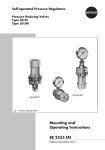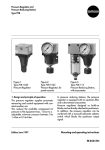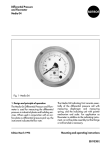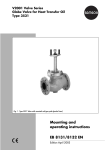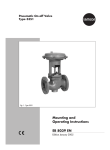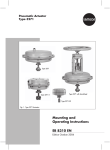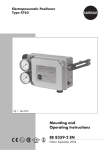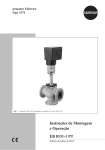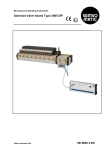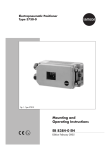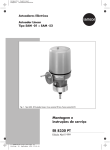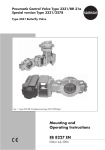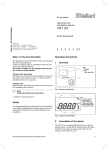Download Position Indicator Typ 4748 Mounting and operating instructions EB
Transcript
Position Indicator Typ 4748 Fig. 1 ⋅ Type 4748 1. Design and principle of operation The Type 4748 Position Indicator is used to ensure a certain relationship between the valve position (travel) and the analog output signal of 4 to 20 mA. If the output signal of the position indicator is transmitted to e.g. an indicating instrument, the current valve travel can be checked and monitored. Edition March 1993 The position indicator is mounted to pneumatic control valves designed as either castiron yoke valves acc. to Namur or valves with rod-type yokes (direct attachment to valve) respectively. Furthermore, the position indicator can be used in combination with the Type 763 or 765-2 Positioners (positioner attachment). Mounting and operating instructions EB 8363 E The valve travel is converted into a rotary motion which is transmitted via pin (1.1) and lever (1) to the solenoid system (2) of the position indicator. As a result, the magnetic field changes and in this way also the voltage in the Hall-sensor (2). The electronic components connected behind the sensor convert this voltage into a load-independent current signal of 4 to 20 mA. 1 For adjustment of zero and span, the position indicator is provided with 4 micro-switches (preadjustment) and 2 potentiometers (fine adjustment). The output characteristic of the position indicator can be reversed by means of a plug which must be turned 180°. This means, the valve position "CLOSED" can be optionally indicated by either 4 or 20 mA. 1 1.1 2 2.1 1.1 3 4 2 5 2.1 6 7 8 Lever for valve travel Pin Solenoid system Sensor with temperaturesensitive resistor Measuring amplifier Switches and potentiometer for pre- and fine adjustment of ZERO Switches and potentiometer for pre- and fine adjustment of SPAN Output stage Constant-voltage source Constant-current source Travel 7 8 Travel 2.1 3 4 5 Zero Span 6 24V Fig. 2 ⋅ Functional diagram 2 1.1 Technical data 4748-0 Output signal 4748-1 Two-wire circuit 4...20 mA Permissible load RB = Output circuit US − 12 V 20 mA — Intrinsically safe Supply Two-wire system 24 V Voltage range 12...45 V Performance Only in combination with an intrinsically safe circuit Characteristic: output proportional to input, conformity error: ≤1 % 1) ≤0.6 % 2) Hysteresis ≤0.1 % Response Effect of supply HF-effect ≤0.1 % with voltage changes within the given limits ≤1 %, f = 150 MHz, 1 watt power output, 0.5 m distance ≤0.1 % Effect of load Permissible ambient temperature Max. 60 °C Temperature class T6 Max. 70 °C Temperature class T5 –20 °C...+70 °C Effect of ambient temperature Ripple of output signal Travel ranges (min...max) Materials Degree of protection Weight 1 2 ≤0.3 %/10 K on lower range value 1) ≤0.3 %/10 K on span 1) ≤0.3 % 1. Positioner attachment 3736/3765: 8...60 mm 2. Lever I: 7...71 mm Lever II: 10...103 mm Housing: Al-diecasting, plastic-coated External parts: 1.4571, Al-black anodized Direct attachment IP 65, see sect. 2.1 Positioner attachment IP 54 (IP 65), see sect. 2.2 ≈0.7 kg ) With max. travel, 100 % = 32° twisting angle ) With min. travel, 100 % = 8° twisting angle 3 2. Attachment Depending on the travel range of the control valve in case of either direct or positioner attachment, the position indicator requires different levers (1), the attachment parts of which are a part of the accessories: Lever for positioner attachment (including intermediate piece, pos. 31 acc. to Fig. 5): Order no. 1400-6710 and Lever I (157 mm) for direct attachment: Order no. 1400-6711 and Lever II (210 mm) for direct attachment: Order no. 1400-6712. The corresponding lever must be mounted prior to attaching the position indicator to the control valve. For this purpose, slide the clamping plate (1.2) over the lever (1), and install both on the sensor shaft. Afterwards, tighten mounting screw. Secure enclosed pin (1.1) with nuts (22) and washer in the opening of the lever. If the pin (1.1) is to be mounted to the clamping plate (20), slide the bracket (order no. 0300-0969) onto the lever. This bracket will then clamp the pin in the oblong hole of the lever. Attention: With this type of assembly, however, a linearity error of up to 1.6 % must be taken into account. For direct attachment of the position indicator to the valve, install the short pin (1.3) in the hole of the positioner lever. 2.1 Attachment to control valves The adapter kit, order no.: 1400-5745, is required for attaching the position indicator to cast-iron yoke valves. For rod-type yoke valves (rod Ø 18 to 32 mm), an adapter kit, order no. 14005342, is required additionally. In addition to the components contained in the first adapter kit, the latter contains a mounting plate (28). For attachment of the position indicator to valves having nominal sizes of DN 150 or larger (Series 240 and 250), proceed as illustrated in drawing no. 1070-6002 Q. 4 The instrument is designed in accordance with degree of protection IP 65. The O-ring (8 x 1.5 mm) contained in the adapter kit is to be placed under the washer (29). 2.1.1 Attachment to cast-iron yoke valves (Fig. 3) Secure plate (20) to the coupling clamp (24) of the valve using the associated screws (21). Unscrew cover of the position indicator. Attach instrument to the valve with screw (11) and washer (29). Make sure that the pin (1.1) is led through the bracket and clamped against the plate (20). Important: When the position indicator is attached to the left-hand side of the valve (view onto plate (20), actuator on top), the pin (1.1) must be clamped against the plate from below, whereas it must be clamped against the plate from the top when the position indicator is mounted to the right-hand side of the valve. 2.1.2 Attachment to valves with rod-type yoke (Fig. 4) Secure plate (20) with screws (21) to the travel indicator (24) of the plug stem. Place mounting plate (28) and clamping plate (26) against the stud bolt (27) and slightly screw them together. Shift mounting plate until the middle of plate (20) and the mounting plate (28) are aligned at 50 % valve travel, and the lever lies horizontally. Tightly screw together mounting plate and clamping plate. Put instrument on the mounting plate, assuring that pin (1.1) is led through the bracket of the plate (20). Tightly screw on position indicator using mounting screw (11) and washer (29). Important: When the position indicator is attached to the left-hand side of the valve (view onto plate (20), actuator on top), the pin (1.1) must be clamped against the plate from below, whereas it must be clamped against the plate from the top when the position indicator is mounted to the right-hand side of the valve. Fig. 3 ⋅ Attachment to e.g. Series 240 Fig. 4 ⋅ Attachment to valve with rod-type yoke 5 2.2 Attachment to positioner 2.3 Housing cover To attach the position indicator with the short lever to a Type 765-2 or Type 763 Positioner, proceed as follows: Install the O-ring (30) on the left-hand and right-hand side of the intermediate piece (31). Insert two screws (33) through the position indicator and the intermediate piece, and place them against the positioner. Insert the nuts (32) in the positioner housing and tighten the screws (33). Fasten pin (1.3) to the lever (1) of the positioner using the nuts (22), so that the short lever of the position indicator is coupled. After the position indicator has been fitted on the control valve, make certain that the vent plug on the housing cover points downwards when the valve is installed in the plant. The instruments are designed in accordance with degree of protection IP 54. For this purpose, exchange the screw plug in the cover of the positioner for the one installed in the cover of the position indicator. For IP 65: Replace vent of the position indicator by a filter (order no. 8504-0666). Sectional view A – B Fig. 5 ⋅ Attachment with intermediate piece to e.g. a Type 765 Positioner 6 3. Electrical connection The terminal assignment is illustrated in Fig. 6 or marked on the PCB. To check and monitor the output signal of the position indicator while adjusting zero and span, an ammeter can be connected to the terminals 81 and 82 when the associated jumper has been removed. The position indicator is operated in a twowire circuit. In general, the supply voltage amounts to 24 V DC. Under consideration of the resistance of the supply leads, the voltage at the terminals must be at least 12 V DC, but not higher than 45 V DC. For instruments designed for application in hazardous areas, the installation regulations acc. to VDE 0165 are to be observed. 81 82 31 32 + Ammeter + Power supply unit Fig. 6 ⋅ Electrical connection 4. Operation 4.1 Adjusting the position indicator 4.1.1 Operating direction For a valve travel of 0 to 100 %, the feedback signal (operating direction either >> or <>) can be adjusted to be within a range of either 4 to 20 mA or 20 to 4 mA. This range depends on both, the attachment position of the position indicator at the valve (direct attachment on the left-hand or right-hand side or to the positioner respectively) and the type of actuator used (models with either spring extending or spring retracting the actuator Attachment to control valve (left) and to positioner (right) stem). The desired operating direction of the output signal is determined by means of a 7pin plug located on the PCB (see table below). The respective operating direction adjusted is indicated by the symbol on the plug facing upwards (either >> or <>). To change the operating direction, slightly lever off the plug at the end before removing it. Then remove the plug completely, turn it 180°, and finally reinstall it. Attachment to control valve (left) and to positioner (right) View onto plate (20), actuator on top Operating direction (symbol on plug) Operating direction (symbol on plug) Valve position >> <> Valve position >> <> Closed Open 20 mA 4 mA 4 mA 20 mA Closed Open 4 mA 20 mA 20 mA 4 mA 7 4.2 Adjustment of zero point and span (Fig. 7) Zero point (ZERO): The zero point is preadjusted using the switches 3 and 4 and fine adjusted at the potentiometer ZERO. This adjustment is always related to 4 mA. Span (SPAN): The span and thus the upper range value is preadjusted using the switches 1 and 2 and fine adjusted at the potentiometer SPAN. This adjustment is always related to 20 mA. Example: Consider a control valve which is moved from the closed (valve CLOSED) to the open position (valve OPEN). The feedback signal must pass through the range of 4 to 20 mA. The position indicator is attached on the left-hand side of the valve. For adjustment of zero and span, connect a suitable power source to the terminals 31 and 32. To check the output signal, remove the jumper connecting the terminals 81 and 82. Then, connect a suitable ammeter. At first, adjust the desired operating direction by properly installing the 7-pin plug. In our example, the symbol <> on the plug must face upwards (see table 1). Should an other symbol be visible on the plug, remove the plug, turn it 180°, and finally reinstall it. control valve to the closed position (valve CLOSED — travel 0 %). Read off the ammeter, the reading must be approx. 4 mA. Use the ZERO potentiometer to correct slight deviations until the ammeter shows exactly 4 mA. If deviations are considerable, use the switches 3 and 4 to set a mA-value which is within the adjustment range of the ZERO potentiometer. Subsequently, adjust this ZERO potentiometer until the ammeter shows exactly 4 mA (zero). Adjustment of span Use input signal to the positioner to move the control valve to the fully open position (valve OPEN — travel 100 %). Read off the ammeter, the reading must be approx. 20 mA. Correct slight deviations at the potentiometer SPAN until the ammeter shows exactly 20 mA. If deviations are considerable, use the switches 1 and 2 to set a mA-value which is within the adjustment range of the SPAN potentiometer. Subsequently, adjust this SPAN potentiometer until the ammeter shows exactly 20 mA (span). Since the adjustments of zero point and span slightly influence one another, the potentiometers must be readjusted until both values are correct. Adjustment of zero point Use input signal to the positioner to move the Fine adjustment Preadjustment Plug for operating direction Fig. 7 ⋅ Adjusters 8 PTB-Certificate for Type 4748-1. 9 EB 8363 E S/C 03.95 SAMSON AG ⋅ MESS- UND REGELTECHNIK Weismüllerstraße 3 ⋅ D-60314 Frankfurt am Main Postfach 10 19 01 ⋅ D-60019 Frankfurt am Main Telefon (0 69) 4 00 90 ⋅ Telefax (0 69) 4 00 95 07










